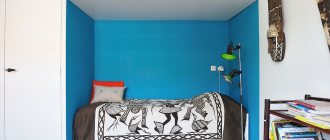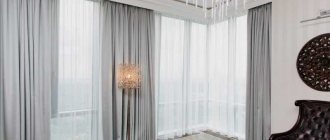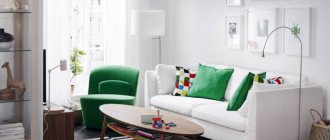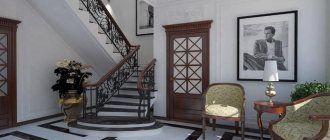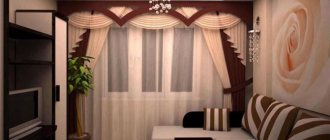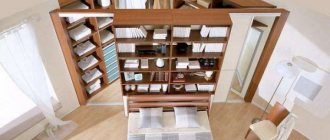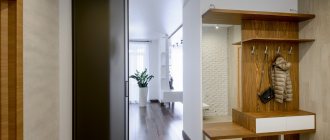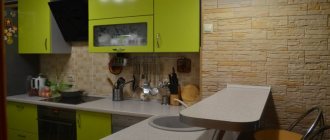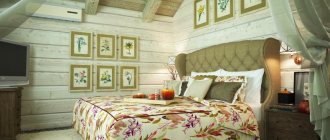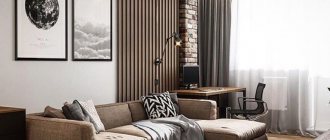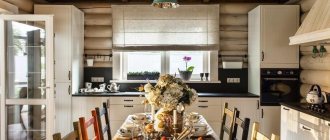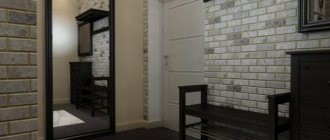Finnish house
The nature of Finland is its heritage. Therefore, when building houses and creating interiors, special attention is paid to the balance between nature and man.
Features of Finnish houses:
- the buildings fit organically into the landscape, the house forms one whole with the landscape
- traditional and natural building materials - wood and stone
- modesty and simplicity of forms and decor
Finnish houses are built from timber, pine or larch (practical and environmentally friendly material).
Since the region is famous for its deposits of sandstone, slate, and granite, they are often used in the construction of houses. Finns often use rubble masonry - the use of natural stones of irregular shape and different sizes. To fully contemplate natural landscapes, houses are built with panoramic windows.
Finnish design: the most popular stool in the world
Stool 60 is a mandatory attribute of all official Apple showrooms and is one of the most popular and most counterfeited interior items. More than 8 million copies have been produced since the early 1930s.
On the subject: Alvar Aalto: a home for a friend
The author of the stool is the famous Finnish architect Alvar Aalto, whose anniversary the world celebrates in 2021. Finnish architect and designer Alvar Aalto (1898 - 1976) built many buildings and about 75 private houses in Europe, the USA, and even Iraq. Throughout Finland there are its universities, libraries, museums, theaters, cultural centers, offices, schools and churches.
Architect Alvar Aalto.
Aalto’s signature style: a combination of functionalism, dictating the severity of forms, and soft, flowing organics in interiors, plus ergonomics and human focus in everything, down to the smallest detail. An example of this handwriting is the chair designed by Alvar Aalto for the Paimio tuberculosis sanatorium (1930s) - its design helped the recovery of patients. The patient, who was leaning back, had an open chest: looking up, he was breathing deeply. The chairs stood under a ceiling painted a glossy sky blue: the shiny surface reflected the trees outside the window.
In the early 1930s, Aalto worked closely with the Finnish furniture maker Otto Korhonen: together they experimented with bent birch plywood and patented the technology for producing furniture from it. The main element they patented was the L-leg support leg: it was smoothly curved at an angle of 90 degrees. According to legend, Aalto came up with such a leg when he was looking at his skis.
The famous stackable stool Stool 60. Artek. 1933.
Based on the L-leg, a whole series of armchairs, chairs and stools was created, and the first in 1933 was the legendary Stool 60 stool with a round seat on three legs - Aalto originally used it in the interiors of the Vyborg library. Then its mass production began, which continues to this day. More than a million original stools made in Finland have been produced since the 1930s. In total, up to eight million such stools were produced by different manufacturers around the world, according to various sources.
The Stool 60 is the world's first piece of furniture made from steam-bent plywood. The material for plywood is wood at least eighty years old from Finnish forests. The light color of the wood is due to the high mineral content in the soil.
Stool 60 is convenient for small apartments: it is stackable - easily stacked one on top of the other. Some guess the DNA-shaped helix in Aalto's stools.
Chair for the Paimio tuberculosis sanatorium. Artek. 1932.
Tea serving table 901, Artek. 1936.
Chaise lounge 43. Artek. 1936.
Pendant lamp A330S. Artek. 1939.
Pendant lamp A338, Artek. 1950.
Pendant lamp A331, Artek. 1953.
Stool X601. Artek. 1954.
In 1935, Aalto, his wife and a couple of like-minded people founded the company Artek, which meant art + technology - now furniture of his design was produced under this brand. Today it is one of the leading Finnish design brands, owning the rights to remake furniture pieces created by Aalto and his wife.
Stool 60, like many other things of the great modernist, are included in permanent museum collections (for example, in the collection of MoMA, Museum of Modern Art in New York). However, they are copied and republished. The reasons are popularity, availability of material and ease of manufacture, which means low price and potential for mass sales. The well-known copyist of the “great Finnish stool,” the Swedish company Ikea, sells its version of “Frost” for about 10 euros. The original from Artek costs 200 euros.
Finnish house interior
Finnish interior captivates with its practicality, conciseness, simplicity and comfort. It can be characterized by the phrase “warm minimalism.” The Finns' love for nature is expressed in everything: in the use of natural stone and wood, in respect for the environment, in how many animal and plant motifs they use in design.
Focus on work
The Finnish approach to life is characterized by patience and perseverance, and one of the favorite national sayings is: “What must be done will be done, no matter what.” Perhaps this motto helped Finland become a country with one of the highest standards of living.
What is sustainable design
By the end of the 20th century, the love of creators for nature collided with the environmental situation in the world and took shape in a new interior direction - eco-design. Let's find out what kind of interior is considered eco today.
Doing work with a laptop in bed or sitting at the kitchen table is not like Sisu. You need to concentrate on work, so an important element of the Finnish interior is a separate workplace.
This is either a full-fledged office, or a dedicated area in the living room, preferably hidden behind a partition or shelving so that there are no distractions. It is not in the Finnish nature to be distracted at all - you need to work, go towards the goal, keep a clear mind. And only when the work is done can you relax.
The decor in such offices is always minimal, but there is maximum convenience and functionality. Every detail has been thought out: lighting, ergonomics, colors - everything contributes to productive work and does not evoke thoughts of leisure.
Finishing
The traditional finishing material for the interiors of Finnish houses is, of course, natural wood. There’s nowhere here without him! It is impossible to imagine walls and floors without wood trim. And sometimes the ceiling. Moreover, preference is given to light tones of wood - this visually expands the space and fills the Finnish house with warmth and comfort.
White or cream plaster is used for ceilings. It would seem that in tandem with light wood the interior should look like a hospital ward. But no! Bright little things save the day - paintings, funny prints on pillows and blankets, carpets and curtains.
Light a fire and keep warm
Summer heat in Finland is considered to be a temperature exceeding 20 degrees, but even that may not happen. Cool, rainy summers, well known to residents of St. Petersburg, are also commonplace for our European neighbors.
In winter in the southern part of Finland, sunlight is in short supply, daylight hours last no more than six hours, and in the very north of the country the sun does not appear above the horizon at all for several weeks, this is the polar night - “kaamos”.
To avoid the winter blues, Finns make up for the lack of sunlight and warmth with regular visits to the sauna and a live fire in the interior.
The sauna is one of the national symbols of Finland and an integral part of the country's rhythm of life. There are saunas in most Finnish country houses and even in apartment buildings.
A fireplace: wood-burning, bio or electric is another popular component of the Finnish interior, with which it is easier to survive the long and cold fires. And candles become a favorite decoration, which are burned not only on holidays and special occasions, but just like that every evening.
Artificial lighting is also abundant, multi-layered, and there are many mobile lighting fixtures.
Furniture
Finnish furniture is stylish, functional and laconic. Chairs, sideboards, tables, armchairs are most often made of wood (pine, birch, beech, oak). But this is not important. The main thing is that the material is good and can be recycled. If it is glass or plastic, please, the main thing is high quality.
For Finns, saving space in the house is important: there’s already not much space, why clutter it with furniture?! Therefore, the furniture is multifunctional: a bed with built-in drawers, wardrobes, folding chairs and sofas, tables with drawers. Finns generally love smart design.
Living room in the spirit of Finland
Finns are very family-oriented, so the living room is the heart of the home for them. Here they spend time with family, relax and have get-togethers with friends. Finland likes open, bright and uncluttered spaces, with a minimal set of furniture in the living room.
For upholstery of the sofa, it is better to choose natural fabric: linen, leather or suede. He will be accompanied by a couple of armchairs and ottomans, if the size of the room allows. Let's add a chest of drawers and shelves made of natural wood, a small coffee table, several floor lamps and lamps. More textiles: a soft carpet in the Scandinavian style, plus a bright blanket with pillows for the sofa and armchairs. The ideal Finnish living room is ready!
Distinctive features of the style
- Layout. The Finnish style is characterized by the currently fashionable free layout of the home. To implement it, it is necessary to demolish the maximum number of non-load-bearing walls, and zone the space using neat partitions and other techniques that leave a lot of free space. The freed space should not be blocked by furniture. Space is the main requirement of style.
- Lighting. Another important thing in a Finnish interior is a large amount of light, both natural and artificial. It is necessary to use all possible lighting options - chandeliers, sconces, floor lamps, table lamps and even furniture lighting. During the day you need to catch every ray of sun, so you shouldn’t overload the windows with decor. Simple linen curtains in natural colors will fit perfectly into the interior.
- Furniture. You need to use only the most necessary furniture and nothing unnecessary. If you choose cabinet furniture, then it should be as functional as possible with many shelves and drawers for storage. This will help you maintain order in your home and quickly find this or that item at any time. As for upholstered furniture, its upholstery is always natural. Suitable materials include linen, leather, cotton or suede. So, depending on the situation, you can choose, for example, a luxurious leather sofa for an office or a simple linen sofa for a relaxation area. Both of them will fit equally well into the overall style.
- Textile. Fabrics in the interior are very welcome. Bright accents are always placed on them. One of the natural shades is chosen as the main tone of the textile, for example, grass, blue-gray, sky blue. Bright sofa cushions or a tablecloth on the table will become a real highlight of your Finnish interior.
- Accessories. There is a huge scope for your imagination - accessories. Firstly, ceramic and wooden decor is traditional. For example, you can create an original composition from unusual branches with your own hands. Secondly, the Finnish interior can look a little like a hunting lodge. It is quite acceptable for one of the rooms to be decorated with guns, horns and animal skins. Moreover, the skins do not necessarily act as carpets. You can use them to make a beautiful wall panel or upholstery for upholstered furniture.
Finnish cuisine
Finnish style is an excellent solution for small spaces. Thanks to the use of contrasting combinations (white, beige, blue or light gray in combination with black or dark brown) and functional furniture of simple shapes, the kitchen looks more spacious and airy. Do you want a more expressive interior? Use bright and rich shades for accents: for example, yellow or green.
In such a kitchen, wooden furniture with metal or glass elements looks harmonious. The kitchen apron is usually finished with tiles or stylized wood panels.
The interiors of all countries are different. But one thing can be said with confidence: a house is a reflection of its owner. Finnish interior is a reflection of a modest, practical and homely person. If this sounds like you, let's incorporate the minimalist yet cozy Finnish aesthetic into your homes!
Seclude yourself
According to Sis, a person sometimes needs to be able to be alone, to focus on his thoughts, to relax, to be imperfect. In the Finnish interior, this need manifests itself in the presence of secluded areas: offices, reading corners in the living room, relaxation areas on balconies.
How to become a successful interior designer: 3 questions to ask yourself
Spoiler: this article is not about the programs and skills that an interior designer should have, but about how to find your client.
What does it take to become an interior designer that people want to work with? First, answer three questions. All of Sisu’s interior recommendations are easy to implement and best suit the situation of the outgoing 2021. It's time to learn from the Finns their resilience, perseverance and indomitable optimism. It’s not for nothing that Finland regularly appears at the top of international happiness rankings.
